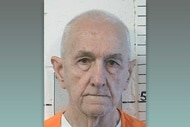Create a free profile to get unlimited access to exclusive videos, breaking news, sweepstakes, and more!
Every Disturbing Detail Of Serial Killer Ted Bundy's Brutal Murders
Despite his cruel and murderous ways, Bundy was often described as “handsome,” “charismatic” and “intelligent.”

He is arguably America’s most infamous serial killer, and his number of victims is surpassed only by “The Green River Killer,” Gary Ridgway. Despite his cruel and murderous ways, he was often described as “handsome,” “charismatic” and “intelligent.” In many ways, he embodied everything we think of when we consider those who kill repeatedly to fill the dark cravings of their psyche and soul.
Ted Bundy’s bloody trail across the United States stretched from the Pacific Northwest, snaked its way through the Rocky Mountains and ended in an explosion of violence under the Florida sun. When it was done, he had murdered at least 30 girls and young women and viciously attacked five others, permanently altering their lives. Authorities still fear that his ultimate body count was far higher than the crimes to which he admitted.
Ted Bundy was born Theodore Robert Cowell on November 24, 1946, in Burlington, Vermont. His mother, Eleanor Cowell, was an unwed 22-year-old, while the true identity of his father has never been known for certain. As a toddler he lived in Philadelphia, thinking his grandparents were his mom and dad. Bundy eventually learned of his true parentage, though there are different accounts of when and how. In 1950, he and his birth mother moved to Tacoma, Washington, where she married a man named Johnnie Culpepper Bundy, who adopted young Ted. They went on to have four children of their own.
Though he would later claim his thirst for sexual violence was triggered by detective magazines and pornography he encountered as a teen, Bundy’s early years showed few signs of the violence that was to come. Circumstantial evidence links him to the 1961 abduction of 8-year-old Ann Marie Burr, but he denied any involvement in her disappearance up until his death. A 2011 DNA test was also inconclusive. He was twice arrested on suspicion of burglary and auto theft, however, the details of both cases were expunged from his record when he turned 18.
After graduating from high school in 1965, Bundy drifted between different colleges before getting his degree in 1972 from the University of Washington, where he made honor roll. In between, he volunteered for Republican presidential nominee Nelson Rockefeller and worked at a suicide prevention hotline in Seattle.
It is not known for certain when Ted Bundy started his misogynistic murder spree. A pathological liar and sociopath, he gave differing accounts to different people after his arrest and conviction. He told forensic psychologist Arthur Norman he killed two women in 1969 while briefly attending Temple University in Philadelphia. Defense lawyer Polly Nelson said in her 1994 book "Defending the Devil" that Bundy claimed his first murder victim was a Seattle woman he killed in 1971. Whatever the start date, by 1974, when the first crimes that police can conclusively attribute to him occurred, he had already mastered the techniques of deception, abduction and murder, leaving behind scant evidence at myriad crime scenes.
Bundy’s first known victim was 18-year-old University of Washington student Karen Sparks. On January 4, 1974, he snuck into her apartment and brutally beat her as she slept with a metal rod, then sexually assaulted her. She remained in a coma for 10 days before recovering with significant brain damage. Less than a month later, he broke into another UW student named Lynda Ann Healy’s apartment, beating her unconscious and carrying her off into the night. Pieces of her skull would later be found on Taylor Mountain, an hour east of Seattle, where Bundy buried many of his victims.
Bundy targeted women throughout the Pacific Northwest, abducting and murdering them on an average of one a month through July of 1974. His victims were all young white females with long straight hair. He traveled as far as Corvallis, Oregon, looking for prey, luring them to his tan Volkswagen Beetle by wearing an arm sling or fake cast and asking for help, then knocking them unconscious, restraining them and taking them to another site where they would be ritualistically raped, tortured and strangled to death. After disposing of their bodies in wooded areas, he would often revisit their corpses to perform sex acts with their remains.
As news of the disappearances spread, police in the greater Seattle area released a composite sketch and details of the suspect, including a description of his car. Several people who knew Bundy, including his sometime girlfriend Elizabeth Kloepfer, reported him as a possible suspect, but nothing came of it. In August of 1974, Bundy moved to Salt Lake City to attend the University of Utah Law School. That September, hunters in Issaquah, Washington, near Taylor Mountain, found the first remnants of his victims.
From his new base in Salt Lake City, Bundy began killing again in the fall of 1974 throughout the Rocky Mountains. On November 8, he posed as a police officer and tried to abduct 18-year-old Carol DaRonch, telling her to accompany him in his Volkswagen to the police station. When he tried to handcuff her, she fought him off and escaped. Later that night, he abducted and murdered Debra Jean Kent, 17. By January 1975, he was traveling deep into Colorado in search of new victims, sometimes driving up to seven hours away. His murders would continue into that June.
On August 16, 1975, Utah Highway Patrol Capt. Robert Hayward noticed a suspicious vehicle in a Salt Lake City suburb early in the morning. When it sped off, he gave chase before stopping at an empty gas station.
"It was the best stop I ever made in my 33-year career," he would tell the Deseret News in 1989. Hayward searched the car, which was missing its passenger side seat. Inside he found pantyhose, a ski mask, a crowbar, an ice pick and handcuffs. Bundy was arrested for suspicion of evading, and he soon became the prime suspect in the Washington and Utah murders.
[Photo: Getty Images]
On October 2, 1975, Ted Bundy was arrested for aggravated kidnapping after being picked out of a lineup by Carol DaRonch. A search of his car later found hairs matching two of his murder victims. On March 1, 1976, Bundy was found guilty of kidnapping DaRonch and sentenced to serve a minimum of one to a maximum of 15 years in the Utah State Prison. That October, Bundy was charged with the January 1975 murder of Caryn Campbell, and extradited to Colorado.
While preparing for trial in June of 1977, Bundy jumped out of a second story window in an Aspen, Colorado, courthouse and evaded capture for days. He spent the next six months planning his next escape. On December 31, with the jail short-staffed due to the holidays, he sawed through the ceiling of his jail cell and escaped.
Bundy then made his way to Tallahassee, Florida. On the morning of January 15, 1978, he broke into the Chi Omega sorority house at Florida State University, where he killed two young women in their bedrooms and severely beat two others. Just blocks away, he broke into another female FSU student’s apartment, beating her so badly severed a nerve that connected to one of her ears. While investigating the attacks, Leon County sheriff Ken Katsarissays noticed bite marks on two of the victims.
“It’s as if he was definitely signing his signature,” he later told People magazine.
Bundy’s final victim was 12-year-old Kimberly Diane Leach, who was last seen outside her junior high school in Lake City, Florida, on February 8, 1978. When her body was found in a pigpen seven weeks later, it showed signs of sexual and physical abuse. Leaving the boarding house where he was staying under the name “Chris Hagen,” Bundy fled Tallahassee days after the Leach killing and headed west.
Kimberly Diane Leach
[Photo: Getty Images]
On February 15, 1978, Bundy was spotted driving a stolen Volkswagen Beetle in Pensacola, Florida. When pulled over by police, he resisted arrest and tried to flee on foot. After being subdued, he allegedly told his arresting officer he wished he had killed him. After giving them a fake name, Pensacola cops didn’t initially realize who they had in custody. After two days, Bundy was interviewed by Police Chief Norman Chapman, and introduced himself as “Theodore Robert Bundy.”
"He was very personable, very charismatic, very un-alarming, and see, that's the dangerous thing," Chapman told Salt Lake City’s KUTV on the 40th anniversary of his arrest.
Ted Bundy went on trial for the Chi Omega homicides and assaults in June 1979. The jury convicted him for the savage attacks of a year and a half earlier, and he received two death sentences for the murder convictions. Six months later, he was tried, found guilty and given a third sentence for the abduction and murder of Kimberly Leach. While being sentenced he proposed to longtime girlfriend Carole Ann Boone, and she accepted, resulting in marriage under Florida state law. Despite not being allowed conjugal visits with Bundy, she became pregnant with his child and in 1982 gave birth to his daughter.
[Photo: Getty Images]
Bundy’s execution for the murders at the Chi Omega sorority house was scheduled for March 4, 1986, but a stay was ordered by the Supreme Court. Other dates came and went, as defense lawyers cited multiple technicalities, before a definitive execution date for the Leach murder was set for January 24, 1989. With nothing left to lose, Bundy came clean about the Washington and Oregon murders and confessed to other killings he was never suspected of, and in some cases, crimes police didn’t even know about.
At 7:16 AM on the morning of Tuesday, January 24, 1989, Ted Bundy was pronounced dead after being electrocuted at Florida’s Raiford Prison. While being strapped into the electric chair, he told his lawyer and a minister, ''Give my love to my family and friends,'' according to The New York Times. A crowd of approximately 200 gathered outside the prison gates cheered boisterously after being informed of his death.
[Photo: Getty Images]































